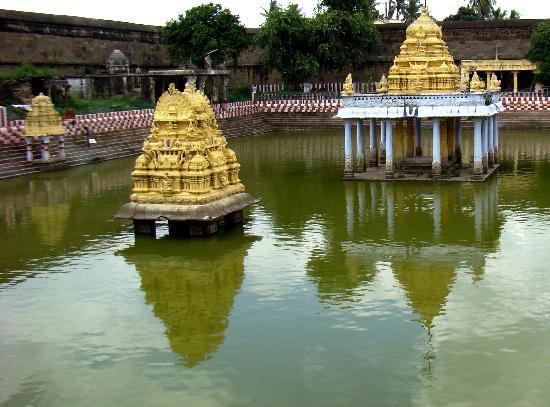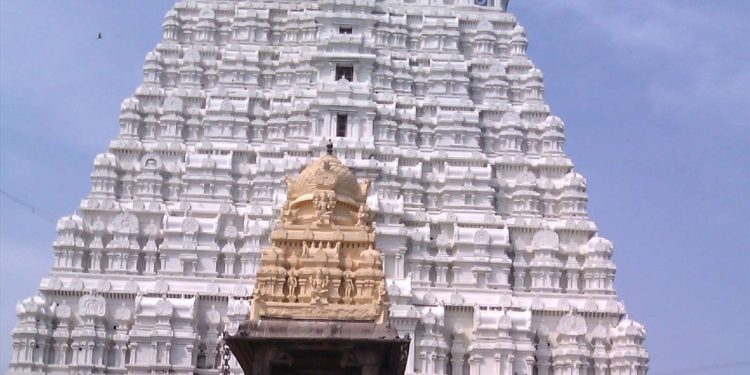Varadharaja Perumal Temple or Hastagiri or Attiyuran is a Hindu temple dedicated to Lord Vishnu located in the holy city of Kanchipuram, Tamil Nadu, India. It is one of the Divya Desams, the 108 temples of Vishnu believed to have been visited by the 12 poet saints, or Alwars. It is located in a suburb of Kanchipuram known as the Vishnu Kanchi that is a home for many famous Vishnu temples.
Shrine’s History
There is a belief that the temple was first built by the Pallava king Nandivarman II. Varadharaja Perumal Temple was originally built by the Cholas in 1053 and it was expanded during the reigns of the great Chola kings Kulottunga Chola I and Vikrama Chola. In the 14th century, another wall and a gopura were built by the later Chola kings. When a Mughul invasion was expected in 1688, the main image of the deity was sent to Udayarpalayam, now part of Tiruchirapalli District. It was brought back with greater difficulty after the involvement of local preceptor who enlisted the services of general To drama. Robert Clive, the British general during the colonial period visited the Garuda Seva festival and presented a valuable necklace, which is adorned during a special occasion every year. There are inscriptions dated 1532 CE indicating the gift of a number of villages made by Achutaraya. Vira Narasingaraya Saluva Nayaka who was directed by Achutaraya broke the royal order by giving more lands to Ekambaranathar temple than the Varadaraja Swamy temple against the instruction of an equal gift to either of the temples.
Achutaraya on hearing this equally distributed the lands to both the temples. In modern times, the administration is carried out by Hindu Religious and Endowment of the Government of Tamil Nadu. There are inscriptions dated 1532 CE record 544 of 1919) indicating the gift of a number of villages made by Achutaraya. Vira Narasingaraya Saluva Nayaka who was directed by Achutaraya broke the royal order by giving more lands to Ekambaranathar temple than the Varadaraja Swamy temple against the instruction of an equal gift to either of the temples.
Achutaraya on hearing this equally distributed the lands to both the temples. There is an inscription from the 13th century from the Hoysalas, indicating a gift of a crown to the presiding deity. During the 17th century, the temple was under the attacks from Mughals headed by Aurangazeb. The idols of the temple were ported to Udayarpalayam in modern day Tiruchirapppali district during 1688. It was only during 1710 that the situation was ripe for the idols to be returned. But the chieftian of Udayarpalayam opposed the move and only after the intervention of Paramahamsa Parivajakacharya Attan Jeer, the idols were returned. The event is commemorated as a festival in the temple.

Legends Associated with This Shrine
Indra, the king of celestial deities, after getting released from the curse of Goddess Saraswati, installed the silver and golden lizards who were the witness of the ordeal. Brahma performed a yagna here, which was about to be washed away by the fast flowing river Vedavathi. The temple deity, Vishnu laid himself flat to stay the flow and the yagna was successfully performed. Vishnu emerged with a brilliance of thousand Suns as Devarajaswamy and stayed here permanently.[4] As is the case with the association of South Indian temples with a sacred tree, the name of the temple, Attigiri is derived from Atti tree, considered sacred to Vaishnavas.
As per Hindu legend, Brahma, the Hindu god of creation, separated with his wife Saraswathi over a misunderstanding. He did an Aswameda worship (with a horse) seeking boons from Vishnu. Vishnu was pleased by the devotion and came out from under the earth as a boar and got Saraswathi unite with Brahma. As per another legend, Saraswathi cursed the king of celestial deities, Indra, to become an elephant and roam around the place. He was relived off the curse with the divine power of Vishnu, who appeared as the mount, Hastagiri. Attagiri indicates the amount in the form of an elephant. As per another legend, the disciples of sage Gautama were cursed to become lizards. They resided in the temple and were relieved of the curse by the divine grace of Vishnu. There is a panel in the temple where the two lizards are depicted in the roof of the temple.
Thirukkachi Nambigal(Also known as Kanchi Purnar) was an ardent devotee of this temple. He used to bring flowers every day from Poovirundhavalli, where he maintained a garden. He did Aalavatta Kaingariyam, waving to produce breeze with the help of hand fan. It is believed that Vardharaja used to converse with him, while he was doing that seva. Aalavatta Kaingariyam is a worship practice followed in modern times also. Nambi also composed Devarajaashtakam(A Sanskrit poem of 8 verses) on the presiding deity. Sri Ramanujar, another great Vaishnavite, got answers to his six questions from Lord Varadharaja through Sri Thirukkachi Nambigal.

Architectural Relevance of This Shrine
The temple covers an area of 23-acre ( complex and shows the architectural skills of ancient Vishwakarma Sthapathis in temple architecture and is famous for its holiness and ancient history. The temple has three outer precincts (prakarams) namely Azhwar Prakaram, Madai Palli Prakaram and Thiru Malai Prakaram. There are 32 shrines, 19 vimanams, 389 pillared halls (most having the lion type yali sculpture) and sacred tanks some of which located outside the complex. The main sanctum faces west and can be entered through a 130 feet tall, 7-tiered raja gopuram (main gateway tower). The eastern gopuram is taller than the western gopuram, which is contrasting to large temples where the raja gopuram is the tallest one.
One of the most famous architectural pieces in the temple is the huge stone chain sculpted in a single stone. There is a 100 pillared hall which has sculptures depicting Ramayana and Mahabaratha. It is a masterpiece of Vijayanagara architecture. The shrine of Varadarajaswamy is on a small hillock 10m tall and a flight of 24 steps, termed “Hasthagiri”. It has murals of the late Vijayanagara empire on the ceiling.
Another significant feature of the temple is beautifully carved lizards and gilded with gold, over the sanctum. The vimana over the sanctum of Varadaraja Swami is called Punyakoti Vimanam and the one over Perundevi Thayar shrine is called Kalyana Koti Vimanam. Apart from the main stone idol, the temple has the wooden image of Varadarajaswamy preserved within a silver box from which water is pumped out every 40 years. It is kept back in the silver casket and immersed in the water. It is believed that there is a heavy downpour after the idol is immersed to fill the tank. The presiding deity is a 10 ft (3.0 m) tall idol made of granite in standing posture, while Thayar is a 4 ft (1.2 m) image in sitting posture.
There is a shrine of Narasimha on the hillock. The origin of the mask of Narasimha is mysterious and believed to possess inexplicable powers. In the second precinct, downstairs contains four shrines, of which the important one is of Malayala Nachiar (Kerala consort), presumably built during the Chera kings in the early 14th century.[12] The third precinct has the shrine of Goddess Perundevi Thayar – it is customary for devotees to visit the shrine first before visiting the main Perumal shrine. There are four small pillared halls, identical in structure, called Thulabara Mandapas built during 1532 for a ceremony of Achutaraya of the Vijayanagara empire. The seven precicnts are called Pradakshina Padha, Hastagiri Pradakshana, Madapalli Pragara, Alavandar Pragara and Azhwar Thiruveedhi.
The Alavandar Pragara houses lot of shrines of the temple. The temple has two towers on the eastern and western sides, which are 180 ft (55 m) and 160 ft (49 m) tall respectively. There is a hundred pillared hall, which has ornate carvings, notable of which being a stone chain. The temple car is believed to have been donated by Krishnadeva Raya in 1517 CE. There are paintings in the temple commissioned during the 16th century under the rule of Vijayanagar kings. The image of Chakrathazwhar (Sudarsana) in the temple is depicted with six hands. Their festival image of the temple has seven different images of Sudarshana depicted within the same Chakra.

Shrine’s Map Location and How to Go There
By Road
From Kanchipuram, there are many auto-rickshaws that drive you to the temple. Kanchipuram is well connected by several bus services from Chennai and other places in Tamil Nadu.
By Rail
Located a km away from Kanchipuram Railway Station. From Kanchipuram Railway Station private taxis are available to reach this temple. Kanchipuram rail-line is connected to Chennai, Pondicherry, Nagaercoil and Madurai.
By Air
Chennai is the nearest airport. From Chennai, the temple in Kanchipuram is 75 km away.
Shrine Timings
1. Bringing Thirumanjanam & Vishwaroopa darshan 6.00 A.M
2. First Thiruvaradhanam 6.30 – 7.30 A.M & 7.30 – 9.00 A.M
Second Nivedanam 10.00 – 11.00 A.M
3. Thirukkapu Sathudal (Closing of Sannidhi) 12.30 – 3.30 P.M
4. Sarva darshan 3.30 – 6.00 P.M
5. Third Thirumalai Sathupadi & Nivedanam 6.00 – 6.30 P.M
6. Fourth Thiruvaradanam 7.00 – 8.00 P.M
7. Manna Senai Theermanam 8.00 – 8.30 P.M













































